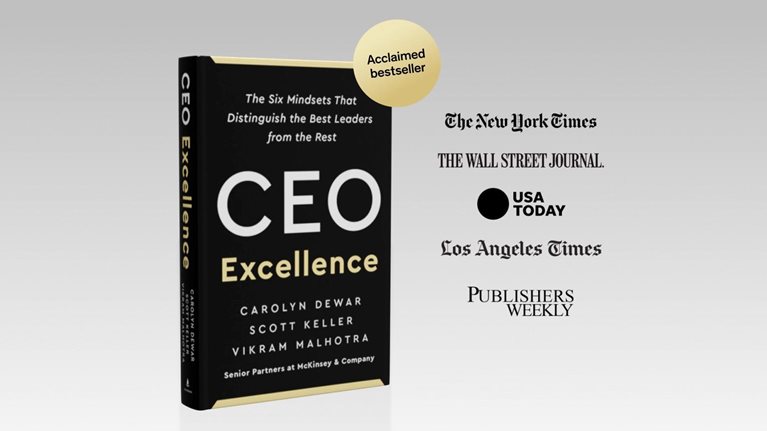Many aspire; few are chosen. Becoming a candidate for the CEO job takes preparation, persistence, and an understanding of the selection process. In this episode of the Inside the Strategy Room podcast, two McKinsey experts share advice from the world’s best CEOs on how to step up to the top job, based on their recent article. Carolyn Dewar co-leads our CEO Excellence practice and Vik Malhotra, former chair of McKinsey’s Americas region, focuses on counseling CEOs and boards. Carolyn and Vik are also co-authors, with Scott Keller, of the New York Times bestseller CEO Excellence. This edited transcript of their discussion is the latest episode in our ongoing series delving into the stages of the CEO journey, which most recently covered making a successful transition into the role. For more conversations on the strategy issues that matter, follow the series on your preferred podcast platform.
Sean Brown: What were the key takeaways from the CEO interviews you did for your book that could guide executives who hope to become CEOs themselves?
Vik Malhotra: The book is based on 67 interviews with outstanding CEOs, and coming out of these interviews, we tried to define what CEOs do as they lead. We boiled it down to six elements: setting the direction, aligning the organization, mobilizing through leaders, engaging the board, connecting with stakeholders, and managing personal effectiveness. These six things in themselves are not rocket science, but we discovered that great CEOs—and, by implication, great leaders—tend to perform all six of these responsibilities well. We didn’t find excellent CEOs who were great at setting the direction but less good at aligning the organization, for example.
That was one big insight for us. The second big insight was that they tended to be great integrators. I was struck by a comment from Microsoft’s Satya Nadella that being a CEO creates an “inflation symmetry problem.” As a CEO, you see more than anyone else in your organization or the people you report to, namely your board of directors. So, integration across the organization is critical.
The other big takeaway, which the book is fundamentally based on, are the mindsets that these great leaders bring to the role. With setting the direction, for example, the mindset of being bold is vital as it plays out in the strategic moves and resource allocation. This really came through in our conversation with Ajay Banga, who took Mastercard from $17 billion to $315 billion in market capitalization during his eight-and-a-half-year tenure as CEO. Ajay’s vision was very bold: he didn’t just want to go after the traditional credit card opportunity; his vision was to “kill cash,” and he brought that to life through new technologies, going after the debit card market, and the like. That boldness is important for aspiring CEOs as well. Around aligning the organization, the mindset of treating the soft stuff as the hard stuff is also a critical one and you see that in how great CEOs handle culture and talent. And on mobilizing through leaders, many of these great CEOs focused on the question, how do you create not just a team of stars but a star team?
Sean Brown: You’ve been interviewing CEOs for our podcast recently, and in your conversation with Stephen Schwarzman of the Blackstone Group, he made the comment that outstanding leaders are built, not born. Do you agree with that?
Vik Malhotra: I completely agree with Steve. It’s the old debate around nurture versus nature. At one level, great leaders come to the role with a certain drive, background, and education, but I think that’s a small part of the equation. For the most part, these CEOs built their skills over time. The eight or ten roles they held before becoming CEO prepared them to be bold in setting direction or to focus their energies on what only they could do in terms of their leadership models. Those are learned skills.
Sean Brown: Did the CEOs you spoke with point to specific things they wished they had known before taking on the role?
Vik Malhotra: Many of them said that they didn’t perform as well as they could have in year one, and much of that came down to time and energy management. The demands of the role were higher than they had expected. The second thing many pointed out was that on engaging the board and connecting with stakeholders, it’s hard to understand how to do that well until you are in the role.
Carolyn Dewar: I would add that even after serving as leaders of big P&Ls, geographies, or business units, the CEOs we spoke with consistently said the job wasn’t what they had thought it would be. More than two-thirds said that in hindsight, they were unprepared. And I think part of the reason so many spoke with us was the desire to share those discoveries with the next generation of leaders: “Here’s what I wish I’d known.”
The buzz of the honeymoon period wears off quickly, so if your motivation was to get the CEO job, not to have the job for an extended time, know that the buzz will wane. It’s truth serum time: ‘Do I want the job because I want to be picked and that will be validating for me?’
Layer on top of that the fact that 30 percent of CEOs today don’t make it past year three in the role. The scrutiny and expectations are so high that you need to hit the ground running. The responsibilities, especially around the board and external stakeholders, are unlike those in any other role. And it’s lonely. Who do you talk to? So we asked ourselves, how can we improve those incoming leaders’ odds of success? How do we help them feel more prepared and how do we make sure that the organizations they lead are receiving CEOs who are ready for the job? We wanted to imagine being several years out, so not about to step into the CEO shoes tomorrow or in the midst of the interview process. How should I get ready if I aspire to be a CEO candidate one day, or how do I help executives get ready if I support leadership development in my organization?
Sean Brown: Your article talks about four key dimensions of that preparation. What’s the first one?
Carolyn Dewar: Start by assessing your motivations and expectations. Do you understand what the CEO job is? Then, having researched all aspects of the role, if you still want it, why? This point about the motivation really came through in our conversations. Satya talked about the job being a 24/7 job, Mary Barra at GM talked about it being all-consuming, and while it allows you to have huge impact across multiple stakeholders, it’s also daunting. Several CEOs talked about how the buzz of the honeymoon period wears off quickly, so if your motivation was to get the job, not have the job for an extended time, know that the buzz will wane. It’s truth serum time: “Do I want the job because I want to be picked and that will be validating for me?”
When we asked CEOs how aspiring leaders can test their motivations, Bill Campbell, who’s had the top job three times (at Intuit, Claris, and GO Corporation) and is a sort of CEO whisperer, at least in the Bay Area, told us that many CEOs secretly think that the job right before CEO can be a better job, because with great opportunity comes huge responsibility. Ken Chenault, the former CEO of American Express, said, “If you want to lead, you have to be committed to serve.” Another CEO talked about how every night, he feels like he tucks in all his stakeholders before he goes to bed—his thousands of employees, the communities he operates in, the customers he serves. It’s the notion that you wake up every day thinking about the impact you can help drive through others and the importance of the decisions you’re making. This cannot be all about you. One CEO said that when he walks into the office in the morning, he looks at his chair and is conscious that he is occupying that chair for a brief period. Greg Case at Aon also noted that part of the reflection should be about the impact on your family and other people in your life. He said essentially, “You volunteer, but they’re conscripted.”
Subscribe to the Inside the Strategy Room podcast
Sean Brown: Did you see any differences between the male and female CEOs you interviewed in terms of their mindsets or areas of emphasis in preparing for the role?
Vik Malhotra: I would highlight one difference: the women CEOs were particularly distinctive on the responsibility to mobilize their teams and solve for the team psychology—and this is off a very high bar. They overinvested in these areas, thinking about the composition of their teams, how to motivate them, and what the teams worked on.
Sean Brown: Thank you. What’s the second piece of advice for aspiring CEOs?
Vik Malhotra: The second area is about elevating your perspective while boldly delivering results. Excelling in your current job is the best pathway to becoming a candidate for a CEO position, in your current organization or elsewhere. I can’t think of a CEO who was put into the role having done a mediocre job in their prior role. Mary Barra was terrific on this. She said, “Do the job you’re doing today like you’re going to do it for the rest of your life, because that means you’re going to invest in it and you’re going to make it better.”
Aspiring CEOs also need to expand their perspective on the future of the company and its industry. I always ask people who are keen to become future CEOs, “Have you written down where you believe the industry is going and where you think your institution fits into that world?” Write down where you would take this company if you were the CEO, because somebody will ask you that down the road. Can you get involved in cross-business or cross-industry initiatives that will elevate your view? Are you building a perspective on the stakeholders from this higher balcony?
The final piece is to continue to be bold, whether in the ambition for your own role or for the company. No one was ever incremental in their attitude and perspective prior to becoming CEO.
Sean Brown: External CEO hires can bring fresh eyes to the company and so more easily get that broader view. How can potential internal candidates get that external perspective?
Vik Malhotra: Let’s be clear: eighty percent of successful CEOs come from within their companies, but many of them think like outsiders. They ask themselves, “If a private equity company were to buy us, what would they do? If an activist were to come here, what thesis might they have?” It’s also useful to have your own board of directors of sorts—external constituencies that can push your thinking. They could be lawyers, bankers, consultants, friends, or colleagues from prior jobs who can serve as sounding boards.
Sean Brown: The third category of advice is to round out your profile with humility. What does that entail?
Carolyn Dewar: This is about building your skill set. If you ask people whether they are above average drivers, 80 percent will say yes. It’s the same with likability: something like 87 percent of people think they are in the top 10 percent of likability. We have built-in biases that we wouldn’t be doing what we’re doing if it wasn’t the right thing. So in your development path toward a CEO role, the first step should be to objectively assess your capabilities against what’s needed.
Brad Smith at Intuit used a horse-racing analogy: “The reason there are very few Triple Crown winners is because the Kentucky Derby is a very different track than the Belmont.” You need the right horse for the right track. Likewise, being a strong CEO doesn’t involve a generic set of skills. You have to be grounded in what the company needs of its next CEO. Given where the company is going, what skills does that CEO need, and are you a good fit for that profile? We often ask boards, CEO candidates, or even retiring CEOs, “What does the next era need to be about? Is it about growth, innovation, efficiency? And what does that imply for the knowledge, skills, experience, and character traits the next leader will need?” I love Vik’s provocation: write it down. “Given my thesis on the future of the business, what qualities would be critical for leadership to have and how do I stack up against them? Are there ones where I have proven skills? Are there areas where I have gaps and need to round out my experience?” You can engage others in the organization as well. If you know that you’re a CEO candidate, you could ask, “What experiences can we create to help me round out that last piece?”
Eighty percent of successful CEOs come from within their companies, but many of them think like outsiders. They ask themselves, ‘If a private equity company were to buy us, what would they do? If an activist were to come here, what thesis might they have?’
One common gap is the external perspective. You would need your organization’s approval but joining the board of a private company or a not-for-profit would give you a chance to sit on the other side and hear the conversation when the CEO is out of the room. Several CEOs we spoke with said that experience made them realize that board governance is different from what they had expected. Also, if you came up through a certain function or business, try to get exposure to other parts of the company. If you have never attended or presented on an investor or earnings call, consider ways to get those experiences. This isn’t just about checking the boxes for the CEO job; these experiences can make you a better leader in your current role. Also, look for chances to practice operating on a bigger scale to gain that enterprise view Vik was talking about. It could be a stretch assignment or an enterprise-wide initiative you can co-lead that will help you build your chops in wielding a broader influence.
As you do all this, it’s important to not play politics by cutting down others or working the process. That will be transparent to the organization.
Sean Brown: The final dimension is understanding the selection process. Would this process be different for every organization?
Vik Malhotra: Yes, but a typical archetype, particularly for a competitive selection process, is the board of directors engaging an executive search firm. The firm will identify internal candidates and probably a few external ones. Understanding that process is critical to putting your best foot forward. Once you are part of the process, you have to articulate a bold vision for the company and how you as the next CEO could deliver against it. Sometimes you may worry about how your bold vision will resonate with the board or the current CEO because it questions some things the company pursued historically, so you have to walk a fine line. But you do need a bold perspective and you should be articulate and clear about it. Remember that in 2014 everyone assumed Microsoft would get an external CEO, but Satya came into that boardroom with a bold vision about where he wanted to take the company in cloud, gaming, and a number of other areas.
Carolyn Dewar: Being clear about your vision also helps you establish your mandate, so if and when you get the job, you are aligned with the board on what you will do. You don’t want to find yourself in a job that you are not excited about.
Vik Malhotra: The second dimension on which I would highlight putting your best foot forward is formulating crisp and compelling answers to anticipated questions. I’ve seen successful CEO candidates put a lot of time into this preparation, going through mock interviews with close advisers who pushed them on the answers and helped them prepare for the personal nature of some of the questions that could be asked.
The final piece is to remain true to your authentic self. At this point, we are who we are as leaders; we will not change our styles dramatically. The key to being your best authentic leader is to manage your energy during this process. It may take 12 to 18 months, so it can be draining.


